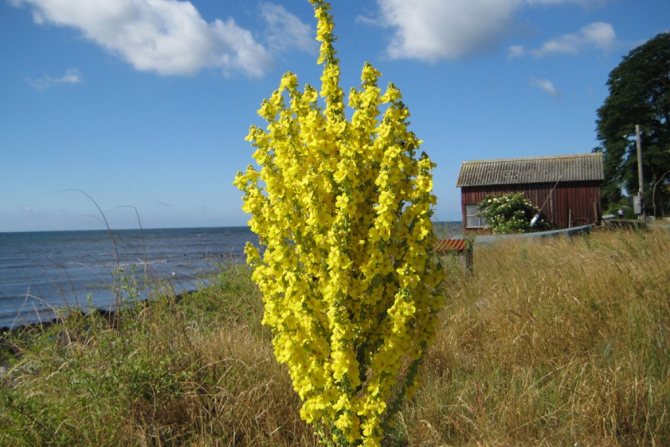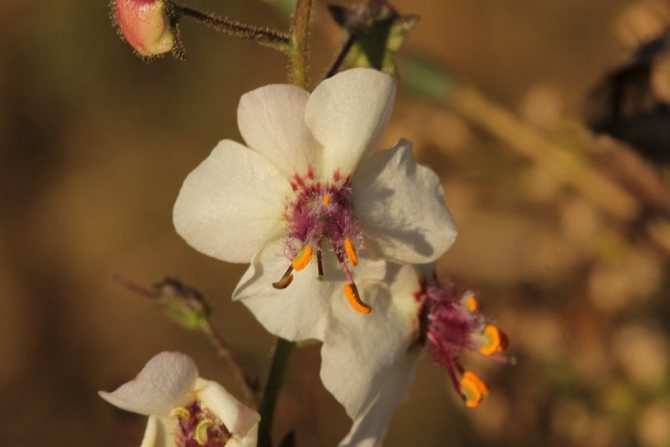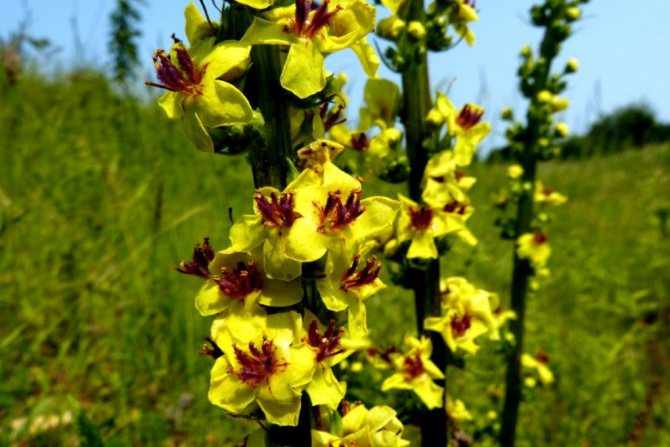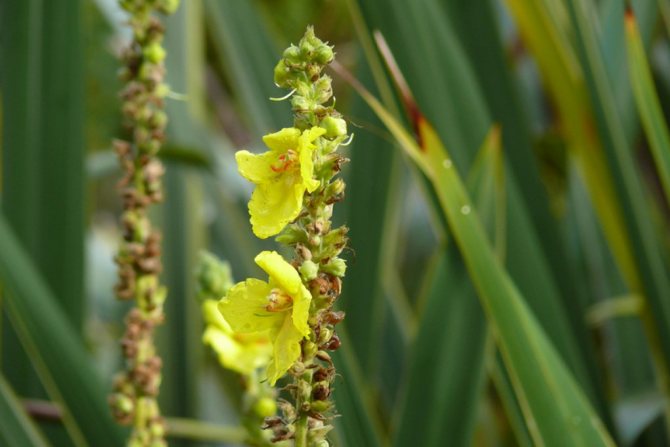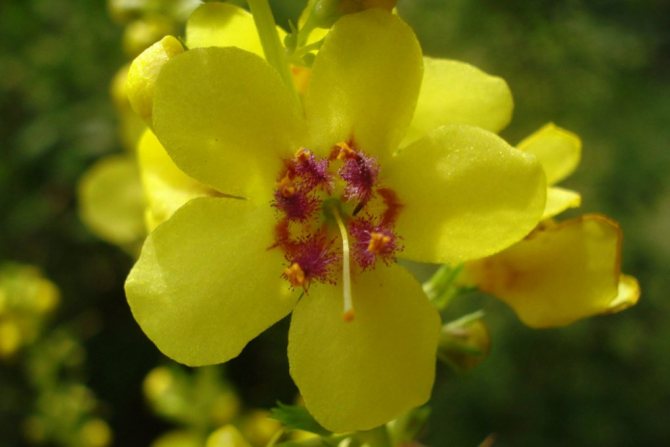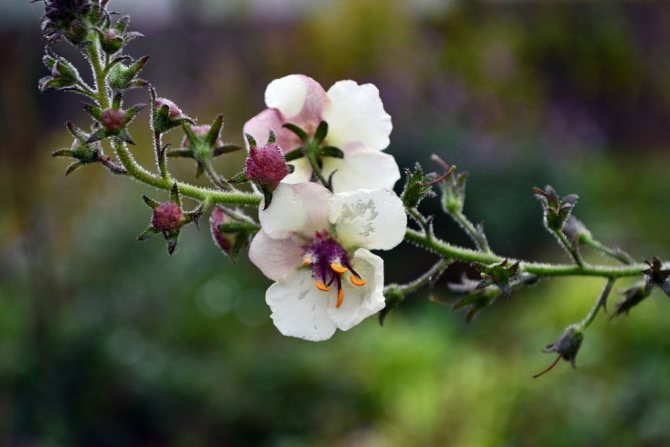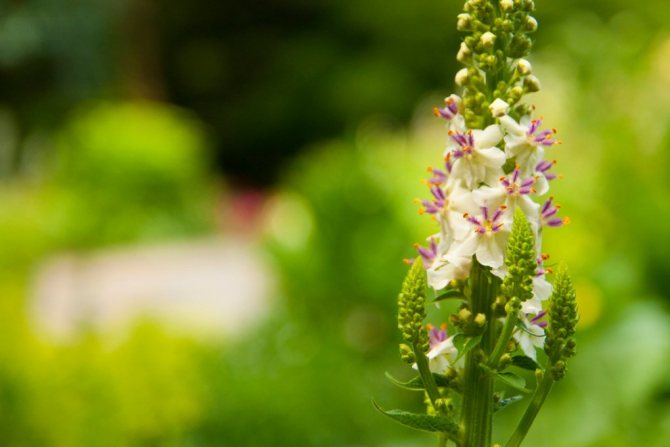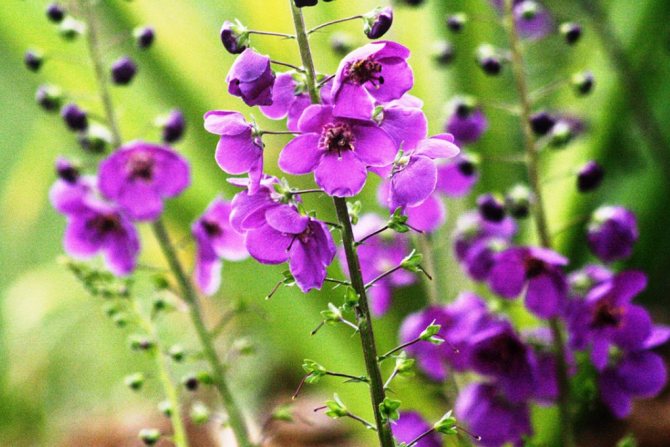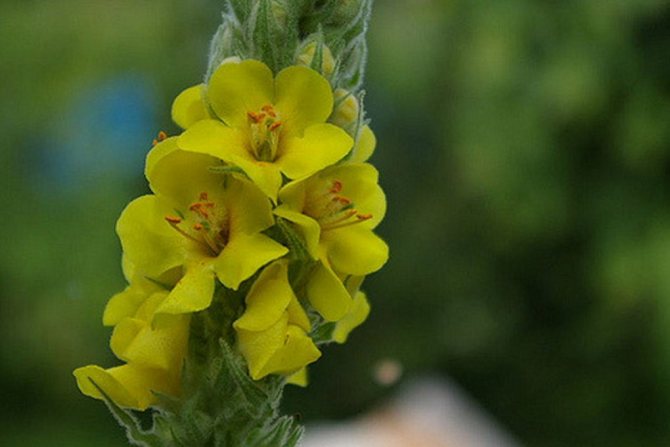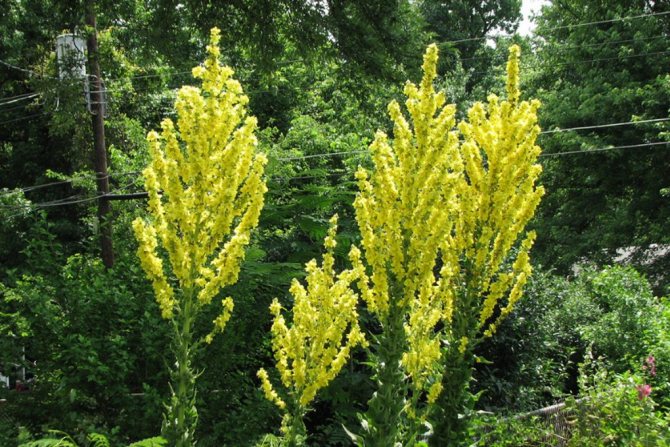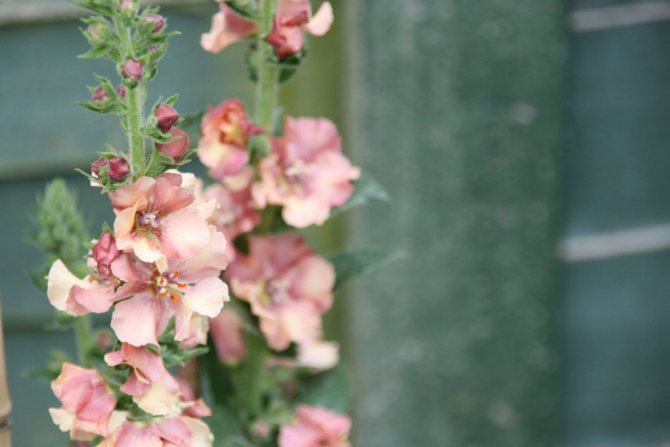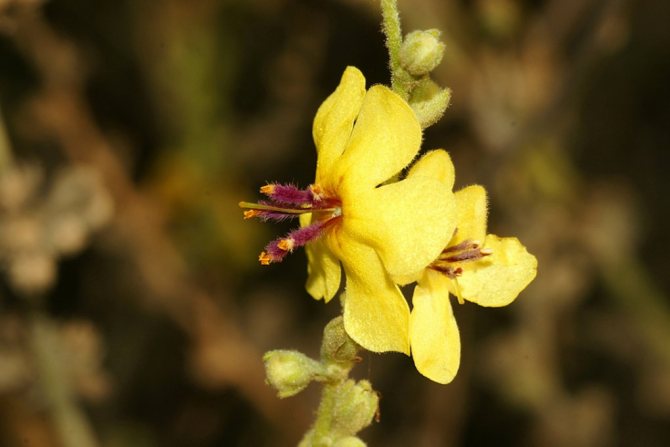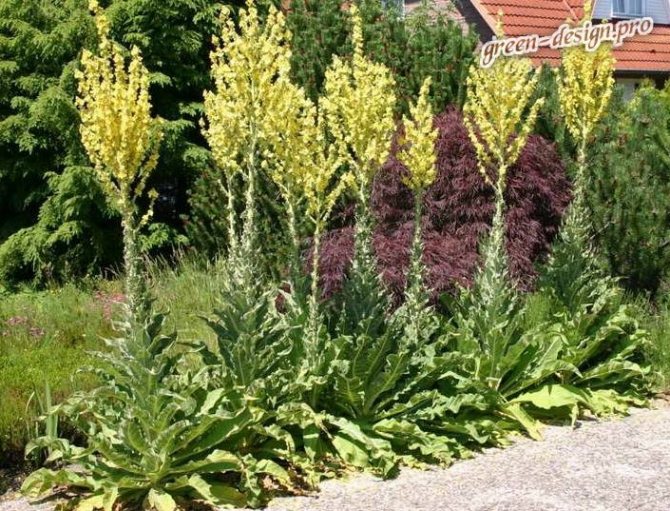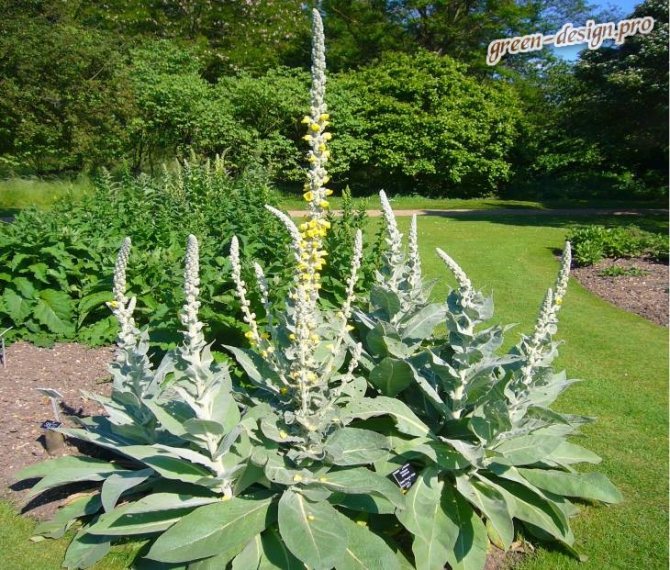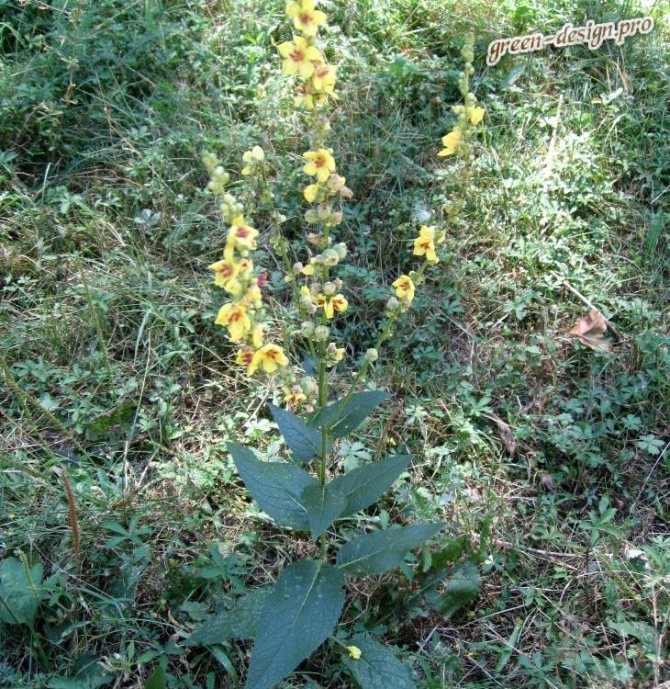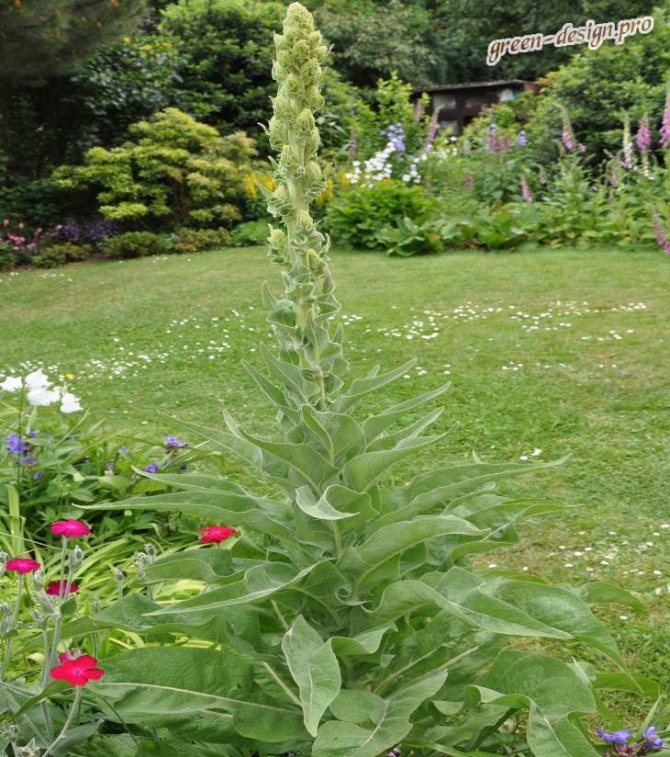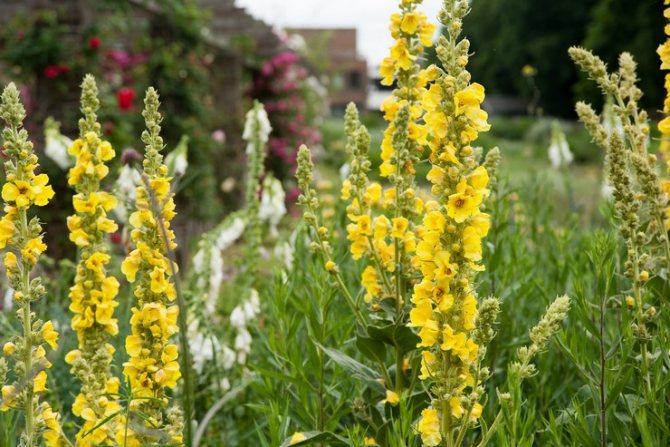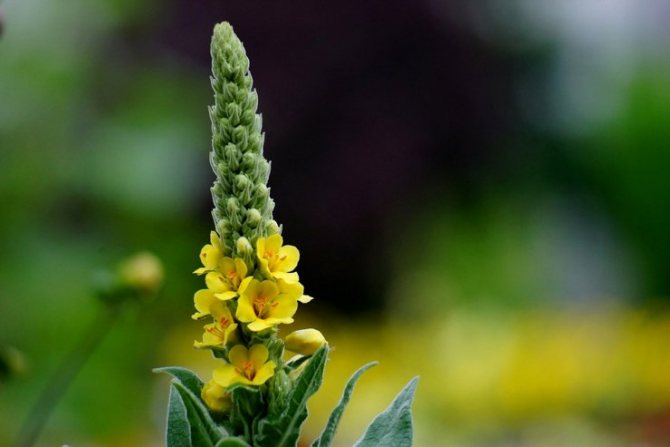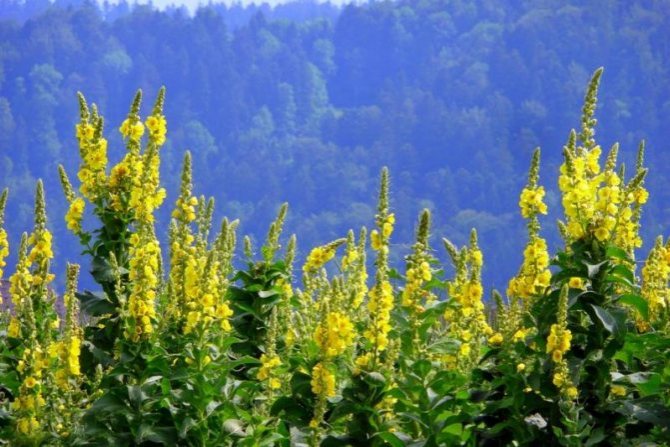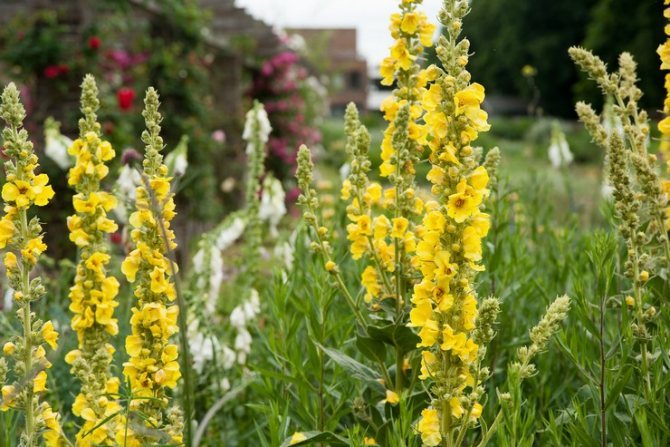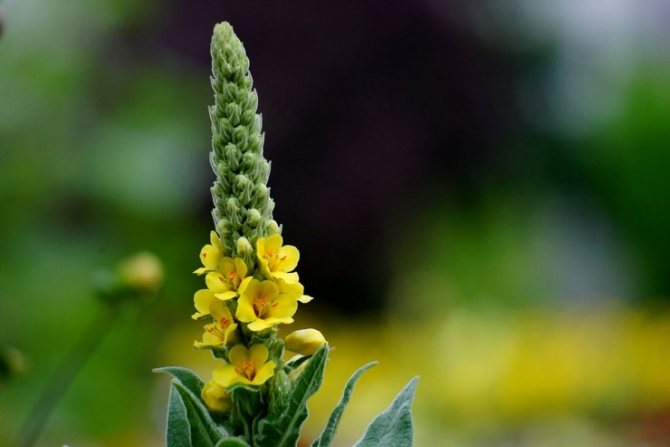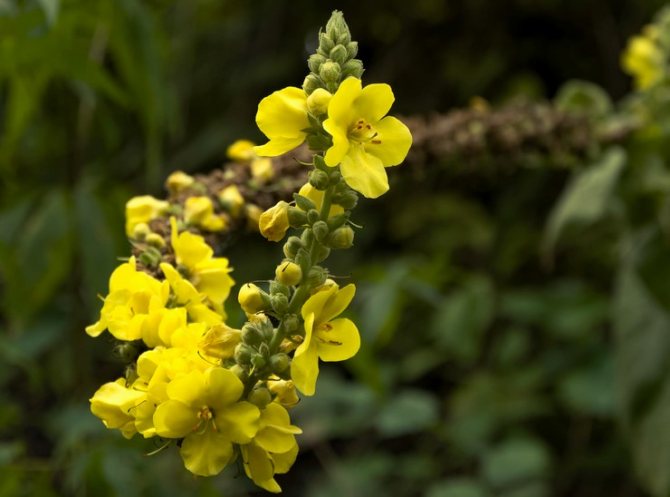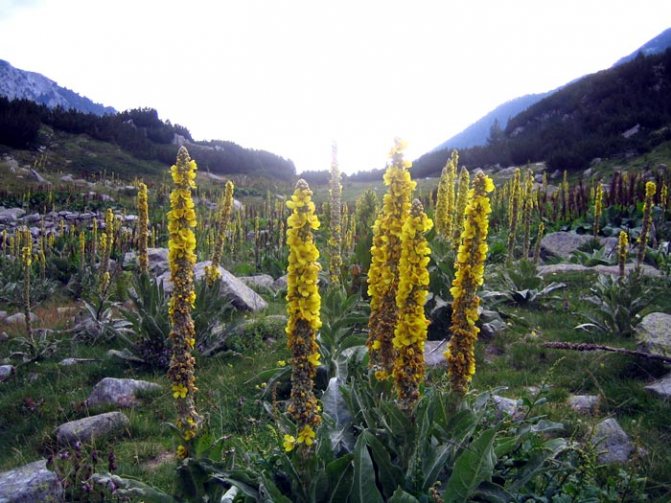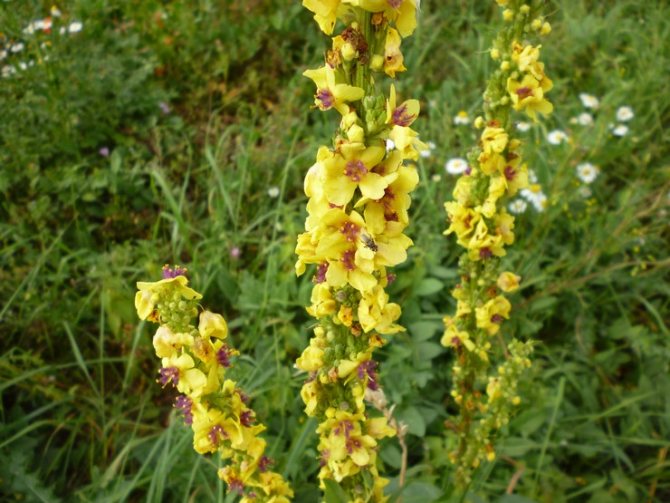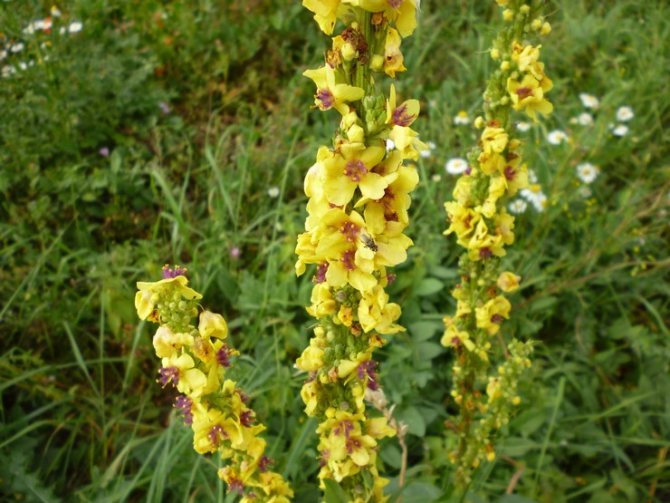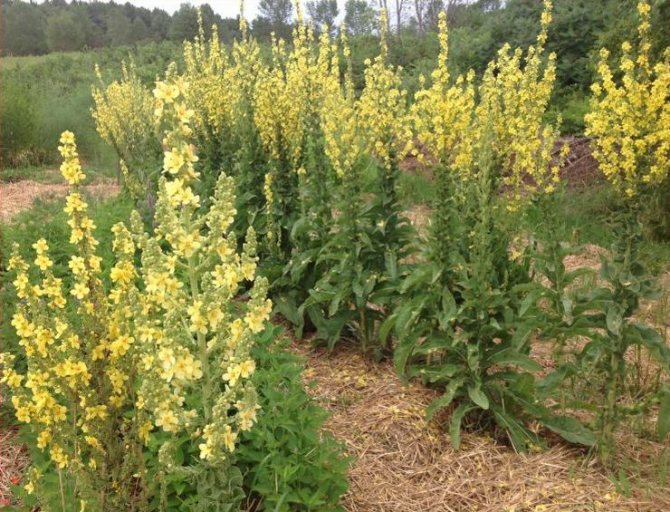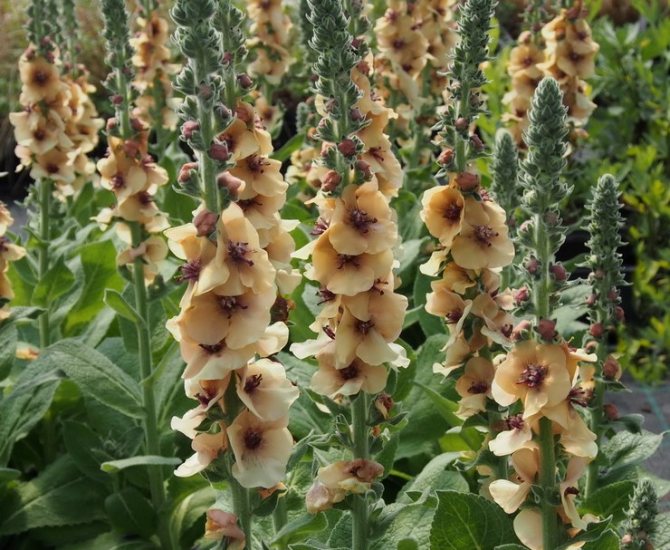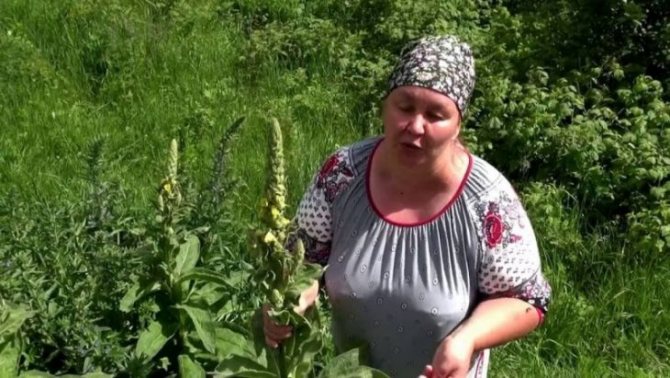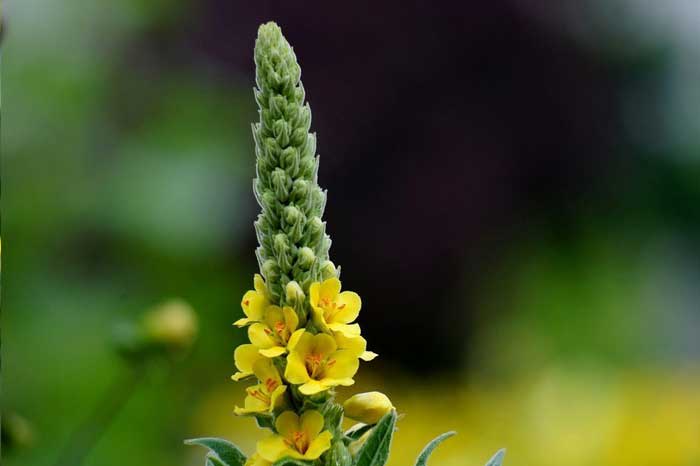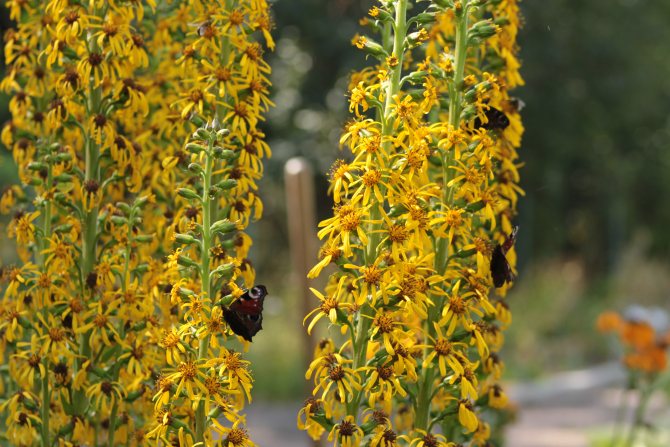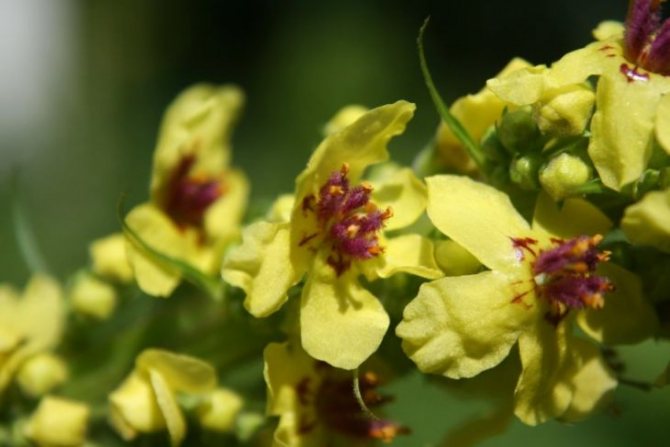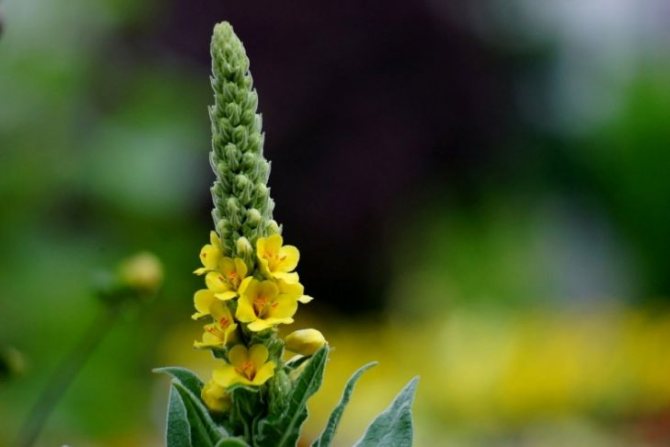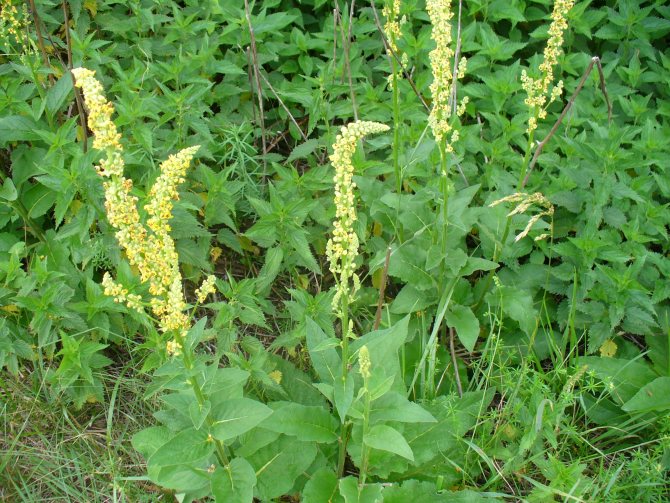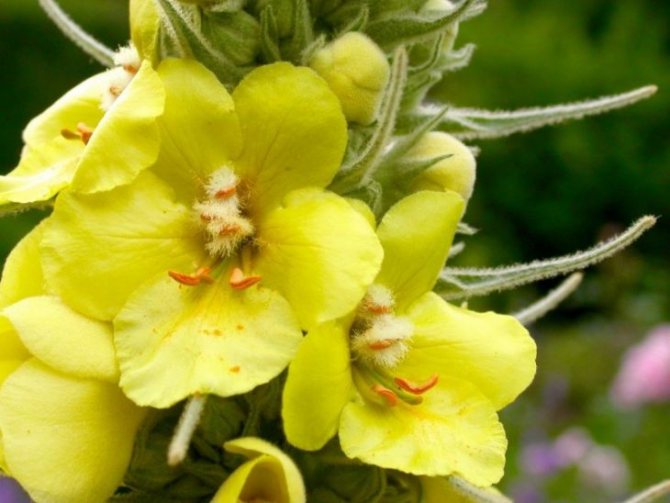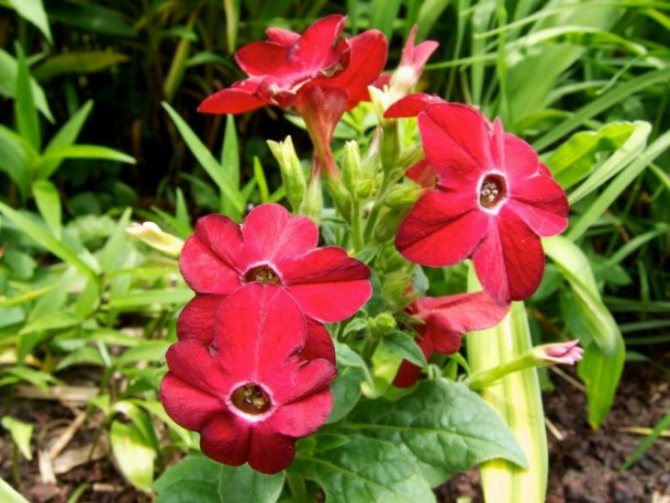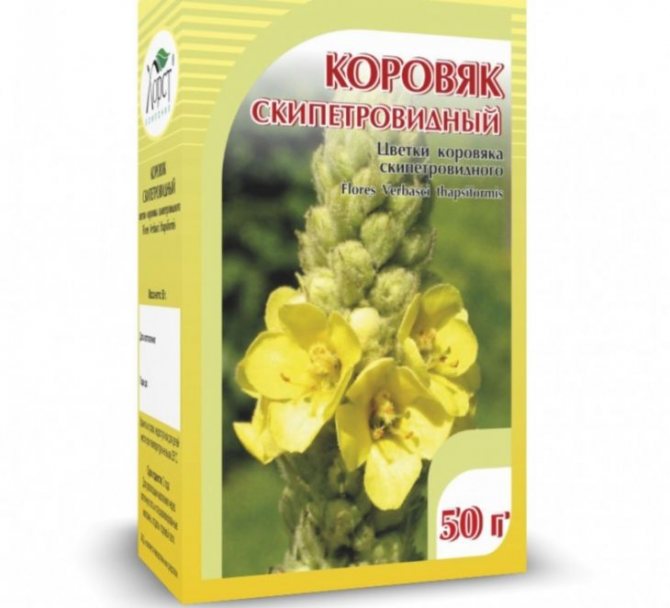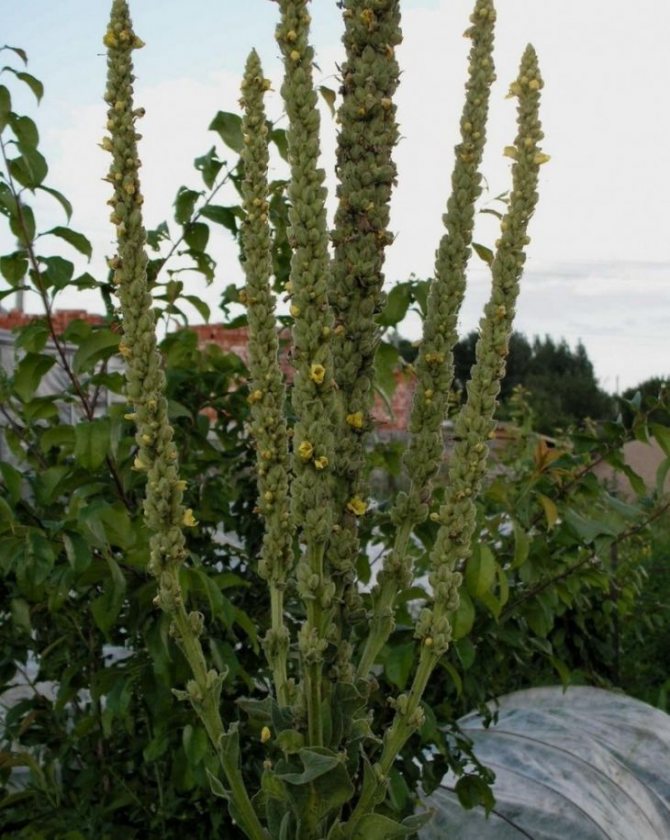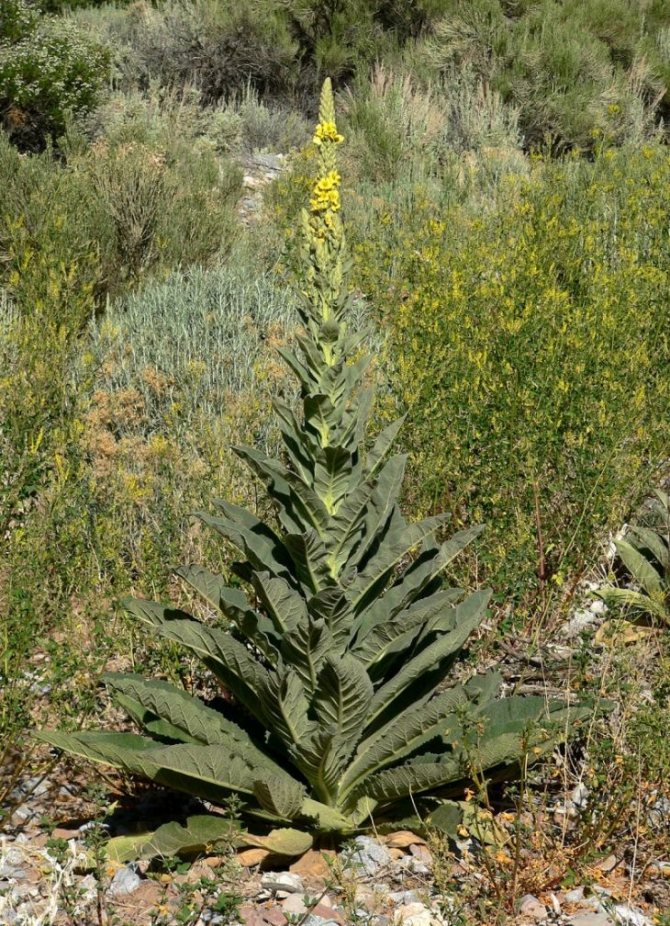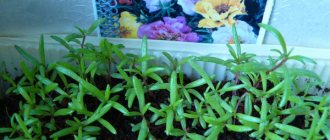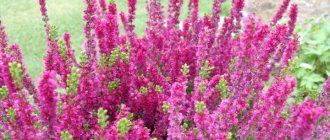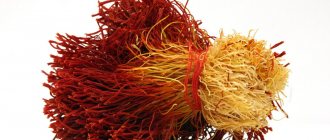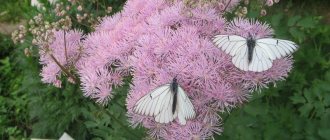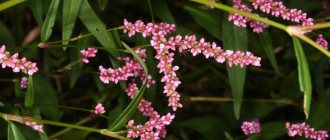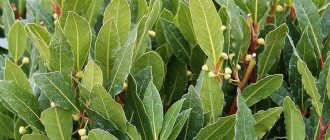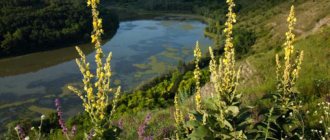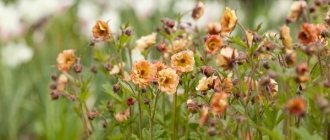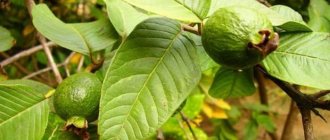Mullein is a stately plant from the Norichnikov family. It is home to the Mediterranean, USA and East Asia. The plant is also known by its Latin name - verbascum, but in our country it is not used so often. Attracts the mullein with abundant flowering. The tops of its stems are completely hidden under the bright, fragrant flowers. Not a single passer-by can pass by without admiring the yellow, pink or snow-white inflorescences. Bright flowers attract birds and beneficial insects, so the garden will be filled with chirping and buzzing from early morning. In care, the mullein is completely unpretentious, and its beautiful flowers are not only pleasing to the eye, but also help to improve health.
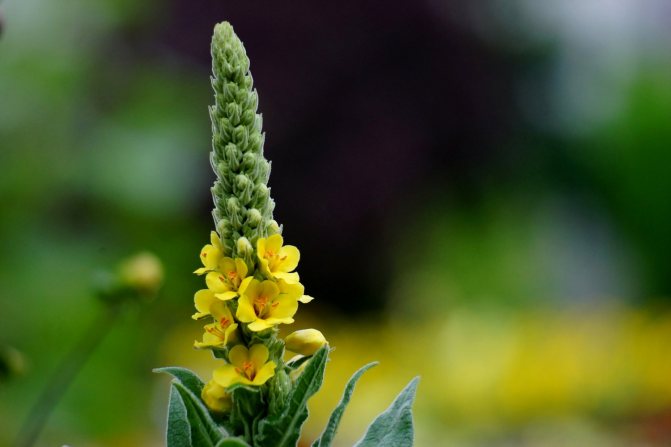
Botanical description
Mullein is a biennial or perennial plant, although annuals are also found in nature. It has a strong tap root and an erect, almost unbranched stem 0.5-3 m high. At the base there is a rather dense basal leaf rosette. The lower leaves have petioles half the length of the leaf plate. Sessile foliage is located higher along the stem. It is attached opposite or in a spiral. The leaves have a solid oval or heart-shaped leaf blade. Their entire surface, as well as shoots and flowers, is densely covered with felt pile. Shoots and foliage are dark green or gray-green.
From the second year of life, a long stem, which is crowned with an inflorescence, develops above the leaf rosette. A flowering ear consists of several tiers of buds. At the bottom there are bunches of 4-7 corollas, and at the top there is a bunch of 1-4 smaller flowers. Corolla diameter is about 2 cm. It consists of yellow drooping petals and has a tubular or funnel shape. Under the fluffy, wide-open petals, 5 stamens, different in size and shape, are hidden. Flowering continues throughout the summer.
After pollination, a small oblong seed capsule ripens. It is also densely pubescent. Inside are small oblong seeds. Their rough surface is colored yellow-brown.
The chemical composition and application of bear ear
It turns out that this seemingly quite ordinary flowering grass contains a huge amount of active substances. It should be noted that the main ones are iridoids, which are a subspecies of monoterpenes:
- Catalpol;
- Aucubin;
- Harpagid.
But there are many other components in the composition of the aboveground parts:
- phenol carboxylic acids;
- bioflavonoids;
- tannins;
- slime;
- polysaccharides;
- essential oils;
- saponins;
- gum;
- beta carotenes;
- coumarin;
- glucose;
- ash;
- essential fatty acids;
- a large number of trace elements, including: Mo, Li, Ni, Cr, Se, B.
Mullein species
The genus of the mullein is very diverse, with more than 250 plant species recorded in it. Only a few are found on the territory of Russia. They are adapted to climatic conditions and have excellent medicinal properties.
Sceptre mullein (densely flowered). The plant is 20-120 cm tall and has a thick, straight stem that is densely foliated. The lower oval leaves reach 10-40 cm in length, and the size of the upper ones is only 4-10 cm. The long spike-shaped inflorescence is dotted with bunches of yellow flowers.For the similarity of the inflorescence with the golden royal scepter, the variety got its name. The diameter of each corolla is 3.5-5 cm. Fresh flowers have a delicate pleasant aroma, while dried flowers have a more intense honey smell.
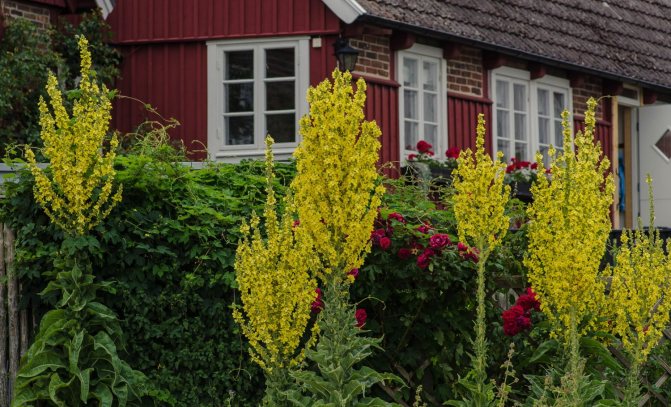

Sceptre mullein
Common mullein (bear ear). All parts of the plant are densely covered with long silvery hair. Dark green foliage is located almost along the entire length of the shoot and only the very top is crowned with a short spike-shaped inflorescence. The lower petiole leaves are 15-30 cm long. Their size gradually decreases upward. Due to the gradually shrinking leaves, the plant resembles a cone from a distance. The inflorescence consists of many small flowers up to 2 cm in diameter.
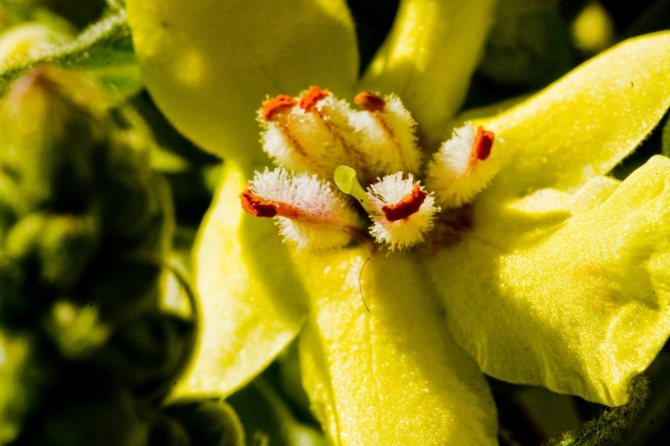

Black mullein. The plant is 50-120 cm tall and has erect stems. Large foliage is located only in the lower third of the shoot. The lower petiole leaves are ovoid or heart-shaped. They are 20 cm long. The long inflorescence is covered with bunches of small yellow flowers. There are brown spots at the base of the petals, and the columns of the stamens are decorated with purple villi.
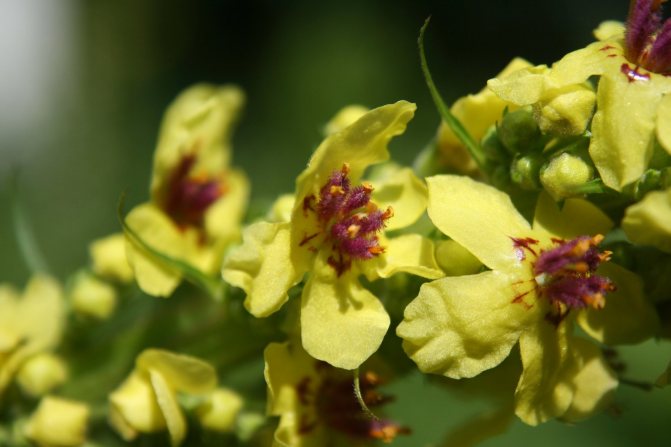

Black mullein
Mullein medicinal. Stems 0.5-1.5 m high, densely covered with foliage. In the upper part there is a long inflorescence, which sometimes branches into several shoots. All parts of the plant are covered with thick felt pile. Oval leaves with a blunt edge are 15-25 cm long. Flowers with soft, long petals are collected in groups along the entire length of the inflorescence. Their diameter is 3.5-5.5 cm. The anthers are colored red.
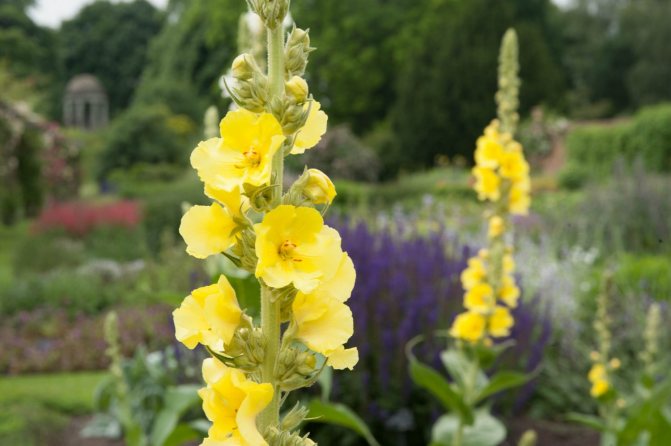

Mullein officinalis
Mullein hybrid. This decorative variety was obtained by interspecific crossing. Its advantage is large flowers of the most varied colors. The height of the shoots depends on the variety and can be less than 50 cm or almost 1.8 m. Popular varieties:
- Mont Blanc is a tall plant with large snow-white flowers;
- Herry Helen - the inflorescence consists of large (up to 10 cm in diameter) bright pink flowers;
- Jackie is a dwarf variety up to 45 cm high covered with smoky pink flowers;
- Pink Domino - orange streaks are visible on large crimson flowers.
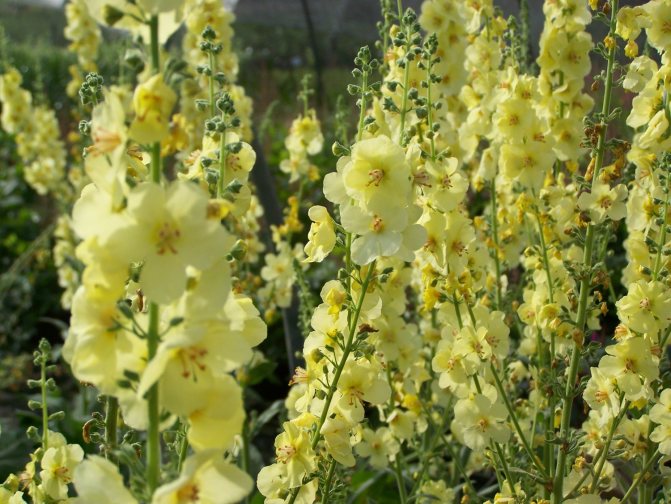

Mullein hybrid
Bear ear in traditional medicine
In folk medicine, mullein is used as an independent component of infusions and decoctions, but it can also be used in combination with other medicinal herbs.
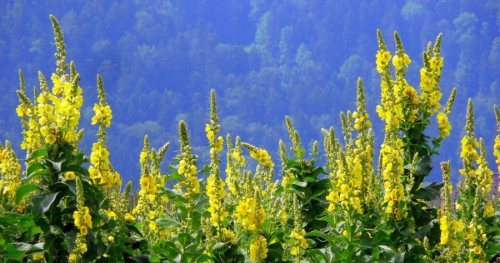

Mullein officinalis
As a cough remedy, an infusion of a mixture in equal parts of bear ear and plantain is used. With external hemorrhoids and itching in the anus, it is recommended to add infusion from the bear's ear to the bath.
An extract is made from the flowers of this medicinal plant and mixed with olive oil. This royal oil is good for treating various ear diseases - boils, pain in the ear canal, chronic inflammation in the middle ear.
Royal oil has no side effects and contraindications, only it is not recommended to exceed the dosage.
Watch also a video on the topic:
Reproduction methods
Mullein propagation can be carried out by sowing seeds or rooting cuttings. The seeds remain viable for a long time and are resistant to frost, so they can be sown directly into open ground. The plant also often self-seeds. Due to the core rhizome, which goes deep into the soil, it is not worth replanting the mullein. Therefore, sowing seedlings is impractical. In open ground, seeds are sown immediately to a permanent place. This is done in mid-May or later, when the average daily temperature is set at + 13 ... + 18 ° C. Seedlings appear in 1-2 weeks. In the first month, seedlings grow very slowly. Later, they develop rather quickly and do not require much maintenance. Flowering is expected in the second year of life.It should be remembered that the mullein is easily cross-pollinated, so the seedlings can be very different from the mother plants.
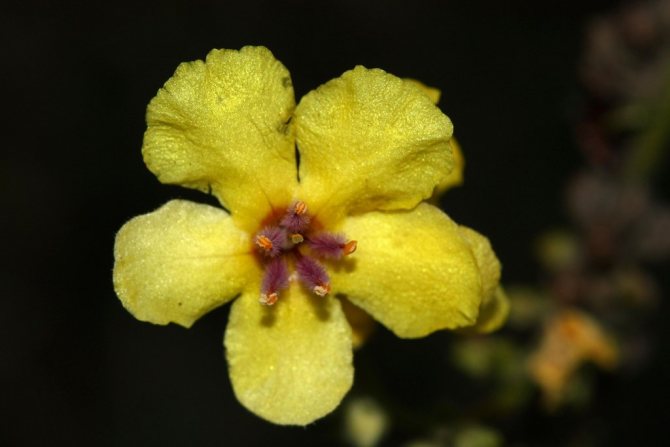

Cutting helps to preserve varietal characteristics. Cuttings should be cut after the end of the flowering period (August-September), then the likelihood of successful rooting will be much greater. The main plant with basal shoots is dug up and freed from the ground. The root is cut into several pieces with buds or small shoots. The length of each rhizome should be at least 5-7 cm. The strips are laid horizontally in prepared holes. First, they are covered with a layer of sand 5 mm thick, and on top - with earth to a height of 15-20 mm. A distance of 40 cm must be maintained between seedlings.
Growing a plant mullein royal scepter
The royal scepter mullein is a biennial plant that grows up to 2 m in height and has a shape similar to a scepter. Small yellow flowers with a diameter of about 1.5 cm are densely placed on the upper half of the stem. They bloom alternately, starting from about the middle of the stem. Thus, the flowering of the mullein occurs throughout almost the entire warm period.
Verbascum leaves are located horizontally above the ground, they are quite wide and pubescent. It has a powerful root system, especially for perennial species.
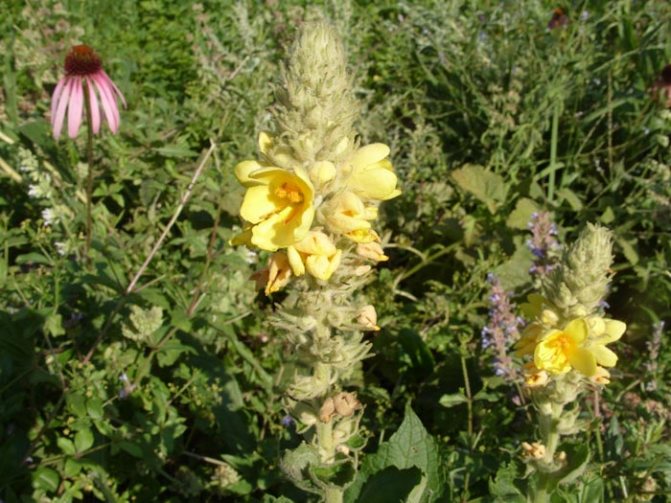

Flowering variety of the Royal scepter
Most often, this plant can be seen on roadsides, in yards, gardens and parks, in fields and forest areas. It also grows in household plots, where it receives proper care, and is subsequently used as a medicine.
Attention! Mullein grows best on sandy soil, although black soil is also suitable for it. You cannot sow the royal scepter mullein into clay soil.
Mullein reproduces in several ways:
- Separation of rhizomes. Since the royal scepter mullein is a two-year-old plant, by the end of the first year of flowering in the last days of September - early October, gardeners dig out the rhizomes and separate the processes. They are treated with disinfectants and planted in the soil. Thus, the mullein reproduces, and a person can control the place where flowers grow so that they are not placed too close to each other. Even before the onset of frost, the divided rhizomes will give small sprouts.
- Self seeding. At the end of flowering, seeds are formed in place of the flower, which, after drying under the influence of wind or rain, leave the mother plant and fall into the ground. This type of reproduction does not require effort, but it has a number of disadvantages: the impossibility of growing in rows, in the presence of several species in the same territory, self-seeding will lead to the degeneration of some of them.
- Growing the royal scepter from the seeds of the mullein plant. This is the most suitable option. It is less energy intensive than separating rhizomes and more controlled by humans than self-seeding. Seeds are collected from the largest inflorescences and dried. In May, they are sown in prepared soil and watered. After a few weeks, seedlings appear that need to be thinned out, leaving only the strongest plants at a distance of at least 30-40 cm from one another. Mullein flowers grown from seeds will bloom in the second year. After which it will be necessary to collect and sow the seeds again.
Attention! Don't bury the seeds too much. It is best to scatter them over the soil, and then sprinkle with a little earth. As it grows, the root system itself will be located at the required depth.
Care rules
The mullein is an unpretentious and lightweight plant. Even a beginner can take care of him. For normal development, the plant needs an open, sunny place. Slight shading is allowed, but with a significant lack of sunlight, the plant will develop worse.
The soil for planting should be loose and light. A sufficient amount of sand, gravel and peat should be added to clay soil. It is better if the land has moderate fertility. Then the mullein can grow on it for several years. But on nutrient soils, it develops worse and often dies at the end of the season.
Watering the mullein is needed only in dry weather. A small amount of water is sufficient. The soil should dry well between irrigations. For a root that goes deep enough into the ground, it will not be problematic to feed on groundwater. But the frequent and prolonged stagnation of moisture in the soil will certainly lead to decay of the roots and the death of the plant.
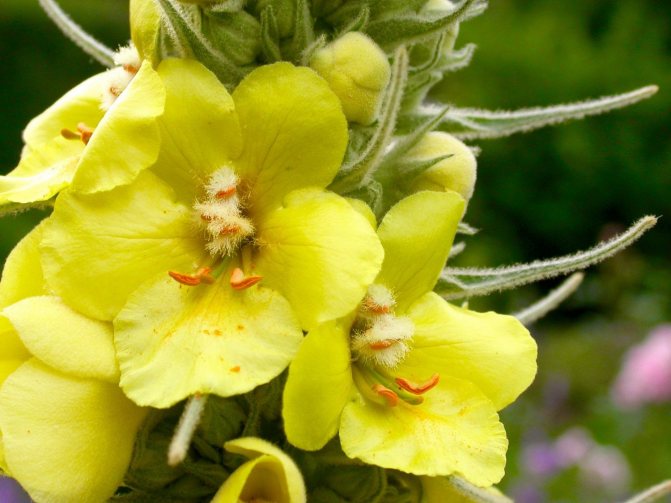

Fertilizing the mullein is extremely rare. One fertilization with a mineral complex is enough during the flowering period. If the soils are fertile, then they do without top dressing at all. For the mullein to live longer than two years, it is recommended to cut the inflorescence before the seeds ripen. After pruning, hybrid varieties are able to bloom again in the same year.
Mullein royal scepter easy to care for
Like any plant, verbascum needs care. But gardeners don't have to spend a lot of time on it.
- Fertilizer. Even before sowing, a small amount of mineral fertilizers is applied to the ground, the soil is loosened with a hoe. Adult plants love feeding with organic or mineral fertilizers, which should be applied to the root zone.
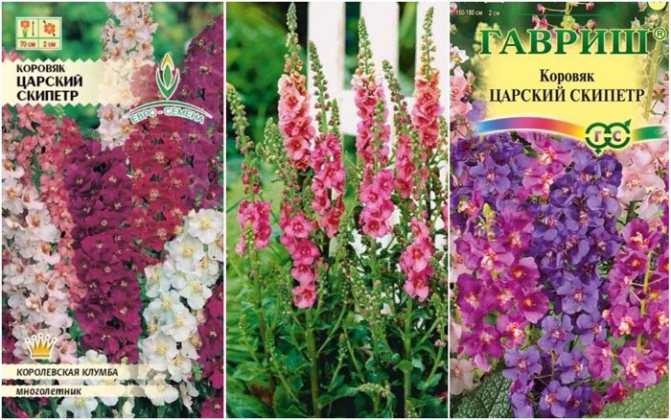

Seeds of the Tsar's scepter
- Weeding. The plant will feel better in loosened soil. Weeds worsen the appearance of the site, take nutrients from the ground, and also create shade, which can damage young mullein seedlings. Therefore, weeds must be removed regularly.
- Mulching. The king's scepter mullein responds well to mulching. Sprinkling the soil with sawdust, bark, wood chips or other substances reduces the number of weeds, saturates the soil with useful substances and just looks aesthetically pleasing.
- Collecting seeds. Having selected several flowers on the stem, they are not removed until the seeds are fully ripe. After the petals are completely dry, the seeds are collected, the remains of the flower are removed and dried in the sun - most often on the windowsill inside the house. It is necessary to store seeds in a paper bag in a room with low air humidity.
- Removing flowers. Since the flowering of verbascum takes place in stages, you need to ensure that wilted flowers are removed in time. Otherwise, they will pull on the power of the plant, slowing down the flowering process of the remaining buds, and after some time they will drop the seeds that have formed into the ground.
- Removing the stem. After the end of the mullein flowering period, it is necessary to completely cut off all the stems, which, after removal, can be put on compost.
- Preparing for winter. Due to the low temperatures in winter, even before the onset of cold weather, you need to make sure that the royal scepter survived the frosts. For this, the rhizomes are sprinkled with ash, sawdust, peat, fallen leaves and even branches.
Use in the garden
Tall plants with such large and beautiful flowers will not go unnoticed in the garden. Especially when it comes to decorative varieties with different colors of petals. Throughout the summer, the mullein will attract insects and birds. It begins to bloom when the primroses have already withered, and later perennials have not yet formed buds. Thus, the mullein fills the pause in flowering. It is important to choose the right neighbors so that the flower garden looks harmonious. They can be orchis, catnip, salvia, anaphalis, sage.
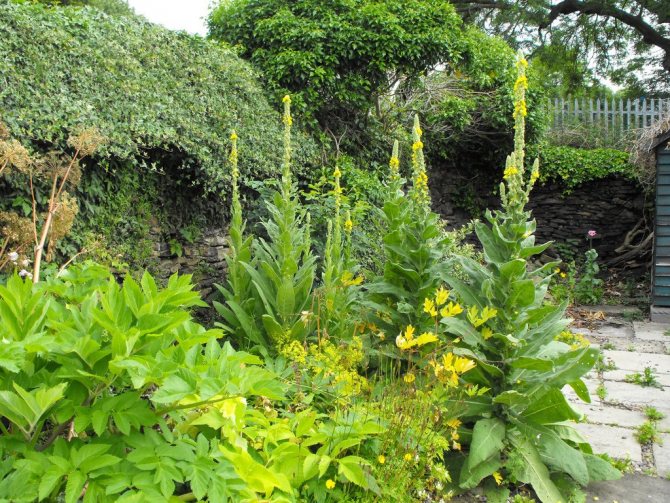

Mullein thickets are also used as a background in the background of a flower bed. It can be planted in small groups in the middle of the lawn, in rockeries or along paths.
Contraindications to mullein treatment
Verbascum is a very healthy plant, but there are still a few caveats.
- Very rarely, a person has an intolerance to this flower.Before use, make a test: spread a small amount of ointment or mullein decoction on a healthy area of the skin. If, after a few hours, redness, burning or other signs of rejection do not appear, you can safely use mullein as a medicine.
- During pregnancy and lactation, you need to use this plant carefully. And it is better to completely exclude it at this time.
The healing properties of the plant
Many varieties of mullein are used in traditional medicine. Its flowers, roots and shoots are rich in tannins, vitamins, mucus, essential oils, flavonoids. Oils, alcoholic tinctures and decoctions from various parts of the plant are used as an anti-inflammatory, expectorant, hemostatic and antimicrobial agent.
Decoctions of flowers are used to liquefy thick phlegm in the bronchi and lungs. Fresh juice is rubbed into the warts to get rid of them. Decoction compresses and masks help fight acne. Alcohol and water tinctures are taken for cystitis, bronchial asthma, hypertension, colds, rheumatism. Mullein is widely used for hemorrhoids, lichen, tuberculosis, as well as liver and gastrointestinal diseases. To prevent infection from getting into wounds, burnt tissues or cracks on the feet, they are sprinkled with dry mullein powder.
Harvesting of medicinal raw materials is carried out during the flowering period. It is important to remember that each flower lives only one day and fades by the evening. Harvesting whole corollas is carried out in the morning. They are dried under a canopy or in drying ovens at temperatures up to 50 ° C. Completely dry raw materials are stored in cloth or paper bags for two years.
Mullein has no contraindications, but it should be taken with caution by people prone to allergies. All drugs must be carefully filtered through several layers of tissue. Even a small amount of villi causes severe irritation of the stomach and mucous membranes.
Prescriptions for various diseases
Upper respiratory tract disease
Collection 1. Preparation of the broth. Boil 1 tablespoon of dried mullein flowers for 10 minutes in a glass of water, cool, filter (remove hairs). Take 1 tablespoon 4-5 times a day as an expectorant and enveloping agent for diseases of the lungs and upper respiratory tract, as well as catarrh of the stomach and intestines, inflammation of the liver and gall bladder.
Collection 2. Preparation of infusion. 5 g of flowers are poured into a thermos with a glass of boiling water and insisted for 2-3 hours. It is taken warm, 1 / 3-1 / 2 glass 2-3 times a day for diseases accompanied by the formation of sputum, as an expectorant, emollient, enveloping agent, externally - in the form of compresses and poultices as anti-inflammatory and wound healing.
Collection 3. Mullein flowers - 1 part, mallow flowers - 1 part, coltsfoot leaf - 1 part, marshmallow root - 1 part. 1 tablespoon of the mixture is poured with 1 glass of boiling water, insisted for 20 minutes. They are filtering. Gargle your mouth and throat several times a day for inflammatory processes.
Collection 4. Mullein flowers - 2 parts, coltsfoot leaf - 4 parts, anise fruits - 2 parts, marshmallow root - 8 parts, licorice root - 3 parts, iris rhizome - 1 part. 1 tablespoon of the mixture is poured with 2 cups of boiling water, insisted for 20 minutes. They are filtering. Take half a glass 3-4 times a day after meals with a cough.
Collection 5. Mullein flowers - 1 part, coltsfoot leaf - 2 parts, fennel fruits - 1 part, marshmallow root - 4 parts, licorice root - 2 parts. 1 tablespoon of the mixture is poured with 2 cups of boiling water, insisted for 20 minutes. They are filtering. Is used for coughing.
Collection 6 Leaf of coltsfoot - 2 parts, mullein flowers - 1 part, fennel fruits - 1 part, licorice roots - 2 parts, marshmallow roots - 4 parts. 1 tablespoon of the mixture is poured with 1 glass of water, boiled for 5 minutes, cooled. They are filtering. Take 1/3 cup 3 times a day for bronchitis.
Growing from seeds at home
The plant does not belong to the category of capricious. Abundant flowering throughout the summer is a definite advantage. The presence of a tap root system allows the mullein to extract moisture from the depths. The presence of pubescence of the leaf plates reduces the evaporation of moisture. The plant can grow both in a sunny area and in a shaded area.
When choosing a place for planting, it should be borne in mind that verbascum will not please with lush flowering on loamy soil. In order to propagate a culture, you need to use seeds. Small seeds are sown in open ground at the end of spring, when the threat of night frosts has passed. The seeds are spread over the bed and lightly sprinkled with a small layer of soil. After the emergence of seedlings, it is necessary to thin them out, leaving only strong and healthy specimens. The distance between plants should be up to 20-25 cm.
Saplings need abundant systematic soil moisture. A year after planting, the plants will begin to bloom. When transplanting a biennial, it is important not to separate the clod of soil from the root system, which will allow the plant to quickly adapt to a new place. Perennial reproduces well by self-seeding.
Note! From the seed collected from one plant, descendants with different colors of flowers grow.
When watering, it should be borne in mind that verbascum does not like swampy soil. Therefore, water is added under the mullein gradually as it is absorbed into the soil. To extend the life of a two-year-old, cut the stems as soon as the flowers begin to dry out. You should not wait for the fruit to ripen. Frequent application of fertilizing to fertile soil shortens the life of flowers.
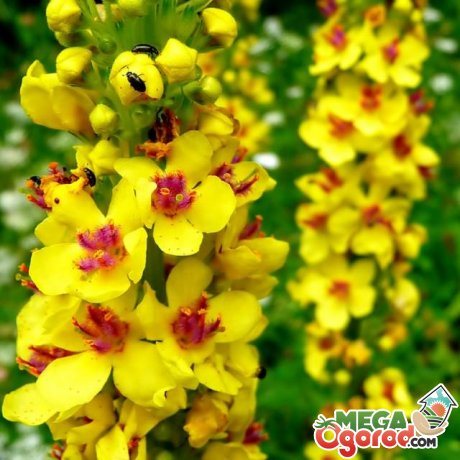

Care features
In order for the plant to bloom for a long time, it is necessary to follow the recommendations of experienced agronomists regarding the care of a two-year-old. Below are the main features of care.
- Top dressing. Before sowing verbascum seeds, it is necessary to add a small percentage of mineral dressing to the soil. After applying the fertilizer, it is recommended to loosen the soil. Organic and mineral fertilizers are suitable for an adult mullein as a top dressing. Top dressing is applied to the root zone.
- Weeding is a necessary item of mullein care. The medicinal plant needs systematic loosening of the soil. Weed grass picks up useful elements and soil and creates additional shading, which negatively affects the development of young seedlings.
- Mulching will have a positive effect on the appearance of the mullein. By sprinkling the soil with sawdust, you can get rid of weeds, saturate the soil with useful elements, and keep the moisture of the earth for a long time. Verbascum is fragrant under similar conditions.
- The removal of flowers is carried out in stages as they wilt. A similar process allows you to slow down the flowering process of the remaining buds and prevent the pulling of forces from the plant. After the culture has flowered, the stems are also cut, dried and used as mulch.
- Cooking mullein for winter. It is necessary to prepare plants for cold weather in October. The root system of the biennial is covered with a layer of sawdust, peat, ash and fallen leaves. The bedding layer should be up to 7-10 cm.
Read also Making a multi-body hive with your own hands
Reproduction
For the purpose of reproduction, the seed method or the method of dividing the bush can be used. Seed material retains germination for a long time. The seeds can be sown directly into the open ground, as the mullein is frost-resistant. In the fields, biennials reproduce by self-seeding. The first shoots appear after 10 days. The seedlings grow slowly during the first months. With proper care, the growth rate increases from 9-10 weeks.
To preserve varietal characteristics, you must use the method of dividing the bush.The process is carried out in September, when the flowering has come to an end. The plant, together with the root, is dug up and shaken off from the earthen coma. The root is cut into 2-3 parts, so that buds remain on each of them. The length indicator of each root should be within 5-6 cm. Each division is placed in separate holes. A small layer of sand is poured over the root with the presence of a kidney. Only then can the depression be filled with soil. The distance between the holes should not be less than 35 cm.
Diseases and pests
Mullein is most commonly harmed by aphids and fungal infections. In order to cope with the pest, you should use drugs of the type:
- Actars;
- Anti-mite Max;
- Decis;
- Inta-Vira;
- Golden spark;
- Calypso Spray;
- Fitoverma;
- Tanreca;
- Tsvetolyuksa.
It is very important to accurately observe the dosage of the drugs. As soon as signs of aphids are found on the plant, you should start processing as soon as possible.
Note! When spraying flowers, it is unacceptable to get the solution on edible plants growing nearby, since the harvest in this case will need to be postponed for a month.
If a fungal infection is found on the flowers, the plantings should be sprayed with Fitosporin-M or Topaz as soon as possible. Fungicidal agents will help to quickly cope with the disease.
Application in landscape design
Flowering spikelets of decorative culture attract the attention of even the most sophisticated grower. Landscape designers use the mullein for planting in small groups on the lawn. Verbascum is also actively used in decorating flower beds on which bulbous perennials are planted. Mullein is ideally combined with salvia, anaphalis, stachis, catnip, orchis.
Luchinnik is an effective medicinal plant that not only benefits the human body, but also decorates the design of the local area. An unpretentious culture can decorate any flower bed.
Watch a video about these beautiful flowers:
Growing a mullein is a pleasure, you just need to know how to properly take care of it. In this article, we will look at all the nuances of care, from sowing seeds, ending with reproduction and prolongation of flowering.

